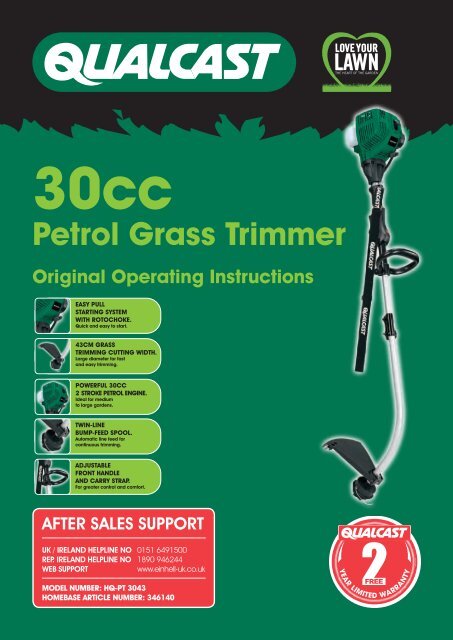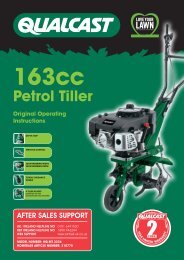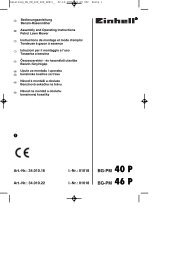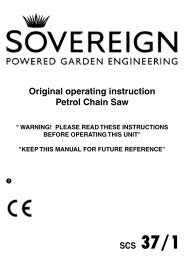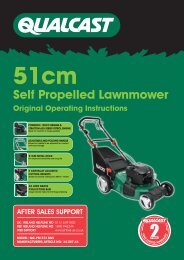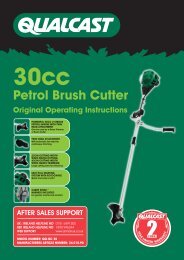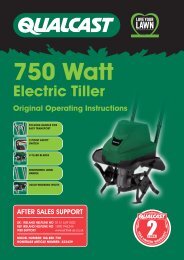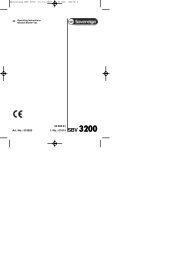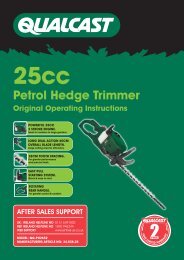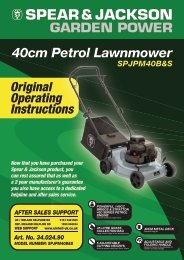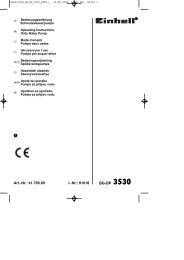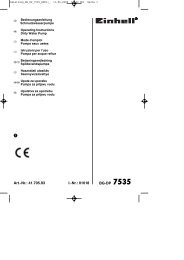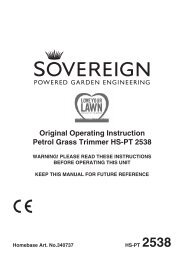You also want an ePaper? Increase the reach of your titles
YUMPU automatically turns print PDFs into web optimized ePapers that Google loves.
30cc<br />
<strong>Petrol</strong> <strong>Grass</strong> <strong>Trimmer</strong><br />
Original Operating Instructions<br />
EASY PULL<br />
STARTING SYSTEM<br />
WITH ROTOCHOKE.<br />
Quick and easy to start.<br />
43CM GRASS<br />
TRIMMING CUTTING WIDTH.<br />
Large diameter for fast<br />
and easy trimming.<br />
POWERFUL 30CC<br />
2 STROKE PETROL ENGINE.<br />
Ideal for medium<br />
to large gardens.<br />
TWIN-LINE<br />
BUMP-FEED SPOOL.<br />
Automatic line feed for<br />
continuous trimming.<br />
ADJUSTABLE<br />
FRONT HANDLE<br />
AND CARRY STRAP.<br />
For greater control and comfort.<br />
AFTER SALES SUPPORT<br />
UK / IRELAND HELPLINE NO 0151 6491500<br />
REP. IRELAND HELPLINE NO 1890 946244<br />
WEB SUPPORT www.einhell-uk.co.uk<br />
MODEL NUMBER: HQ-PT 3043<br />
HOMEBASE ARTICLE NUMBER: 346140
02<br />
Contents<br />
03. Safety Guide<br />
06. Assembly and Parts list<br />
12. Getting Started<br />
14. Operation<br />
19. Trouble Shooting<br />
22. Declaration of Conformity<br />
23. Guarantee Certificate<br />
Helpline No. UK 0151 649 1500 / IRE 189 094 6244
15 m<br />
1<br />
2<br />
3<br />
4<br />
5<br />
6<br />
7<br />
8<br />
9<br />
10<br />
11<br />
Explanation of the information<br />
signs on the equipment:<br />
1. Warning!<br />
2. Read the instructions for use before<br />
operating the equipment.<br />
3. Wear safety goggles, a face guard<br />
and ear defenders.<br />
4. Wear sturdy, non-slip footwear.<br />
5. Wear safety gloves.<br />
6. Protect the equipment from rain and damp.<br />
7. Be careful of objects being thrown out!<br />
8. Always switch off the equipment and pull out<br />
the spark boot plug before carrying out any<br />
maintenance work.<br />
9. All bystanders must be kept at least 15 m<br />
from the equipment.<br />
10. The tool continues to rotate!<br />
11. Caution: Hot parts. Keep your distance.<br />
Helpline No. UK 0151 649 1500 / IRE 189 094 6244<br />
03
Safety Information<br />
1. Read the instructions with due care. Familiarize<br />
yourself with the settings and proper operation<br />
of the machine.<br />
2. Never allow children or other persons who are<br />
not familiar with the operating instructions to<br />
use the petrol grass trimmer.<br />
3. Never mow in the direct vicinity of persons -<br />
especially children - or animals. Warning: Maintain<br />
a safety distance of 15m. If approached,<br />
switch off the appliance immediately. Always<br />
keep in mind that the machine operator or<br />
user is responsible for accidents involving<br />
other persons and/or their property.<br />
Preliminary measures<br />
1. Always wear sturdy, non-slip footwear and long<br />
trousers when operating the machine. Never<br />
operate the machine barefoot or in sandals.<br />
2. Check the grounds on which the machine will<br />
be used and remove all objects that could<br />
be caught up and violently flung out.<br />
3. Warning: <strong>Petrol</strong> is highly flammable!<br />
• Only store petrol in containers designed to<br />
hold petroleum-based liquids.<br />
• Only refuel out in the open and do not smoke<br />
during the refueling process.<br />
• Always refuel before starting the engine.<br />
Do not open fuel tank cap and do not refuel<br />
when the engine is running or when the grass<br />
trimmer is hot.<br />
• If petrol has overflowed, do not under any<br />
circumstances attempt to start the engine.<br />
Instead, remove the machine from the affected<br />
area. Avoid starting the engine until the petrol<br />
fumes have completely evaporated.<br />
• For safety reasons, the petrol tank and other<br />
tank closures must be replaced if they are<br />
damaged.<br />
4. Replace defective exhausts.<br />
5. Before using the petrol grass trimmer, visually<br />
inspect it to ensure that the mounting bolts<br />
and the entire cutting apparatus are in good<br />
working order (i.e. not worn out or damaged).<br />
To prevent any imbalance, replace worn out<br />
or damaged mounting bolts as a set only (if<br />
applicable).<br />
04<br />
Handling<br />
1. Wear close fitting, tough work clothing that<br />
will provide protection, such as long slacks<br />
or trousers, protective footware, heavy duty<br />
work gloves, hard hat, a safety face shield,<br />
or safety glasses for eye protection and a<br />
good grade of ear defenders or other sound<br />
barriers for hearing protection.<br />
2. Store in a safe place. Open fuel cap slowly to<br />
release any pressure which may have formed<br />
in fuel tank. To prevent a fire hazard, move<br />
at least 10 feet (3 meters) from fueling area<br />
before starting.<br />
3. Turn unit off before setting it down.<br />
4. Always hold unit firmly with both hands,<br />
the thumb and fingers encircling the handles.<br />
5. Keep all screws and fasteners tight.<br />
Never operate your equipment when it<br />
is improperly adjusted or not completely<br />
and securely assembled.<br />
6. Keep handles dry, clean and free of fuel mixture.<br />
7. Keep the line spool as close to ground as<br />
practical. Avoid hitting small objects with the<br />
line spool. When cutting on a slope, stand<br />
below stringhead. NEVER cut or trim on a hill<br />
or slope, etc. if there is the slightest chance of<br />
slipping, sliding or losing firm footing.<br />
8. Check the area you will be trimming for<br />
debris that may be struck or thrown during<br />
operation.<br />
9. Keep all parts of your body and clothing away<br />
from the line spool when starting or running<br />
engine. Before starting the engine, make sure<br />
the line spool will not come in contact with<br />
any obstructions.<br />
10. Stop the engine before examining cutting line.<br />
11. Store equipment away from possible<br />
flammable materials, such as gas-powered<br />
water heaters, clothes dryers, or oil-fired<br />
furnaces, portable heaters, etc.<br />
12. Always keep the safety guard, the line spool,<br />
and engine free of debris build-up.<br />
13. Operation of equipment should always be<br />
restricted to mature and properly instructed<br />
individuals.<br />
14. If unfamiliar with trimming techniques, practice<br />
the procedures with engine in “OFF” position.<br />
15. Always clear work area of debris such as<br />
cans, bottles, rocks, etc. Striking objects<br />
can cause serious injury to operator or<br />
Helpline No. UK 0151 649 1500 / IRE 189 094 6244
ystanders and also damage equipment.<br />
If an object is hit accidentally, turn the<br />
engine off immediately and examine<br />
the equipment. Never operate unit with<br />
damaged or defective equipment.<br />
16. Always trim or cut at high engine speeds.<br />
Do not run engine slowly at start or during<br />
trimming operations.<br />
17. Do not use equipment for purposes other<br />
than trimming or mowing weeds.<br />
18. Never raise the line spool above knee height<br />
during operation.<br />
19. Do not operate unit with other people or<br />
animals in the immediate vicinity. Allow a<br />
minimum of 50 feet (15 meters) between<br />
operator and other people and animals<br />
when trimming or mowing. Allow a distance<br />
of 100 feet (30 meters) between operator<br />
and other people and animals when<br />
operating the petrol grass trimmer.<br />
20. If operating on a slope, stand below the<br />
cutting attachment. Do not operate on a<br />
slope or hilly incline if there is the slightest<br />
chance of slipping or losing your footing.<br />
Additional instructions<br />
1. DO NOT USE ANY OTHER FUEL other than that<br />
recommended in your manual. Always follow<br />
instructions in the Fuel and Oil section of this<br />
manual. Never use petrol unless it is properly<br />
mixed with 2-stroke engine oil. Permanent<br />
damage to engine will result, voiding<br />
manufacturer’s warranty.<br />
2. DO NOT SMOKE while refueling or operating<br />
equipment.<br />
3. DO NOT OPERATE UNIT WITHOUT AN EXHAUST<br />
and properly installed exhaust shield.<br />
4. DO NOT TOUCH or let your hands or body<br />
come in contact with the exhaust. Hold unit<br />
with thumbs and fingers encircling the handles.<br />
5. DO NOT OPERATE UNIT IN AWKWARD<br />
POSITIONS, off balance, outstretched arms,<br />
or one-handed. Always use two hands when<br />
operating unit with thumbs and fingers<br />
encircling the handles.<br />
6. DO NOT RAISE THE LINE SPOOL above ground<br />
level while unit is operating. Injury to operator<br />
could result.<br />
7. DO NOT USE UNIT FOR ANY PURPOSES OTHER<br />
than trimming lawn or garden areas.<br />
8. DO NOT OPERATE UNIT FOR PROLONGED<br />
PERIODS. Rest periodically.<br />
9. DO NOT OPERATE UNIT WHILE UNDER THE<br />
INFLUENCE OF ALCOHOL OR DRUGS.<br />
10. DO NOT OPERATE UNIT UNLESS SAFETY GUARD<br />
IS INSTALLED AND IN GOOD CONDITION.<br />
11. DO NOT ADD, REMOVE OR ALTER ANY<br />
COMPONENTS OF THIS PRODUCT. Doing so<br />
could cause personal injury and/or damage<br />
the unit voiding the warranty.<br />
12. DO NOT operate your unit near or around<br />
flammable liquids or gases whether in or out<br />
of doors. An explosion and/or fire may result.<br />
13. DO NOT USE ANY OTHER CUTTING TOOLS.<br />
For your own safety only use the accessories<br />
and additional equipment specified<br />
in the operating manual. The use of<br />
tools or accessories other than those<br />
recommended in this operating manual<br />
may place you in danger of personal injury.<br />
Helpline No. UK 0151 649 1500 / IRE 189 094 6244<br />
05
06<br />
A<br />
B C<br />
Helpline No. UK 0151 649 1500 / IRE 189 094 6244
D<br />
F1<br />
G<br />
Helpline No. UK 0151 649 1500 / IRE 189 094 6244<br />
E<br />
F2<br />
G1<br />
07
08<br />
G2<br />
H<br />
H2<br />
G3<br />
H1<br />
Helpline No. UK 0151 649 1500 / IRE 189 094 6244<br />
I
J1 J2<br />
K1<br />
L<br />
K2<br />
M1<br />
Helpline No. UK 0151 649 1500 / IRE 189 094 6244<br />
09
10<br />
M2 M3<br />
M4<br />
N2<br />
N1<br />
N3<br />
Helpline No. UK 0151 649 1500 / IRE 189 094 6244
N4 N5<br />
N6<br />
O1<br />
N7<br />
O2<br />
Helpline No. UK 0151 649 1500 / IRE 189 094 6244<br />
11
12<br />
Important!<br />
When using the equipment, safety<br />
precautions must be observed to avoid<br />
injuries and damage.Please read the<br />
complete operating instructions and safety<br />
regulations with due care. Keep this manual<br />
in a safe place, so that the information<br />
is available at all times. If you give the<br />
equipment to any other person, hand over<br />
these operating instructions and safety<br />
regulations as well.<br />
We cannot accept any liability for damage<br />
or accidents which arise due to a failure to<br />
follow these instructions and the safety<br />
instructions.<br />
1. Safety information<br />
CAUTION!<br />
Read all safety regulations and<br />
instructions.<br />
Any errors made in following the safety<br />
regulations and instructions may result in an<br />
electric shock, fire and/or serious injury.<br />
Keep all safety regulations and<br />
instructions in a safe place for future use.<br />
Safety devices<br />
When working with the equipment, the<br />
appropriate safety guard must be fitted to<br />
prevent objects being thrown out by the<br />
equipment.<br />
The integrated blade in the safety guard<br />
automatically cuts the line to the optimum<br />
length.<br />
2. Machine description and items<br />
supplied (Fig. A – C)<br />
1. Cutting head<br />
2. Cutting line<br />
3. Safety guard with screw, washer and locknut<br />
4. Long handle with drive shaft<br />
5. Additional handle<br />
6. Engine switch “ON/OFF” (1/0)<br />
7. Throttle lever “release”<br />
8. Throttle lever<br />
9. Fastening eyelet<br />
10. Choke (swivelling)<br />
11. Starter cable<br />
12. Spark plug boot<br />
13. Air filter housing cover<br />
14. <strong>Petrol</strong> tank<br />
15. Housing for engine cooler and starter<br />
16. Fuel pump “primer”<br />
17. Carrying strap<br />
18. Connecting piece for long handle<br />
19. Fuel mixture bottle<br />
20. Spark plug wrench<br />
21. 2-stroke oil<br />
3. Proper use<br />
The machine is designed for cutting lawns and<br />
grassed areas.<br />
Important. Due to the high risk of bodily injury to<br />
the user, the petrol trimmer must not be used to<br />
carry out the following work: to clean (suck up)<br />
dirt and debris off walkways, or to chop up tree<br />
or hedge clippings. Moreover, the petrol trimmer<br />
may not be used to level out high areas such as<br />
molehills. For safety reasons, the petrol trimmer<br />
may not be used as a drive unit for other work<br />
tools or toolkits of any kind.<br />
The machine is to be used only for its prescribed<br />
purpose. Any other use is deemed to be a case<br />
of misuse. The user / operator will be liable for any<br />
damage or injuries of any kind caused as a result<br />
of this.<br />
Please note that our equipment has not been<br />
designed for use in commercial, trade or<br />
industrial applications. Our warranty will be voided<br />
if the machine is used in commercial, trade or<br />
industrial businesses or for equivalent purposes.<br />
Helpline No. UK 0151 649 1500 / IRE 189 094 6244
4. Technical data<br />
Engine type: 2-stroke engine, air-cooled,<br />
chrome cylinder<br />
Engine power (max.): 0.76 kW/1.03 hp<br />
Displacement: 29.7 cc<br />
Idle speed of engine: 2900 rpm<br />
Max. engine speed: 11000 rpm<br />
Max. twin line speed: 8000 rpm<br />
Ignition: Electronic<br />
Drive: Centrifugal clutch<br />
Weight (with empty tank): 5.8 kg<br />
Long handle length: 135 cm<br />
Cutting circle diameter of line: Ø 43 cm<br />
Cutting line length: 5.0 m<br />
Cutting line diameter: 2.0 mm<br />
Tank capacity: 0.6 l<br />
Spark plug: Torch L8RTC<br />
Vibration ahv rear handle: 9.319 m/s 2<br />
Uncertainty of vibration level: 3.7m/s 2<br />
LpA sound pressure level: 92 dB (A)<br />
LWA sound power level: 112 dB (A)<br />
Uncertainty sound level: 1dB<br />
Sound and vibration were measured in<br />
accordance with EN ISO 27917, 10884/7916.<br />
5. Before starting the equipment<br />
5.1 Assembly<br />
5.1.1 Assembly of the long handle (Fig. D-E)<br />
Remove the transport guard cap from the<br />
lower long handle. Slacken the star grip screw<br />
(Fig. D/Item A) on the connecting piece<br />
on the upper long handle (Fig. D/Item B).<br />
Carefully slide the lower long handle (Fig. D/<br />
Item C) into the connecting piece on the<br />
upper long handle.<br />
When doing so, take care to ensure that<br />
the drive shafts on the insides of the long<br />
handles slide into each other (turn the spool<br />
head gently, if required) and that the lock on<br />
the lower long handle (Fig. E/Item D) latches<br />
securely in the connecting piece.<br />
Now retighten the star grip screw (Fig. D/Item<br />
A). To dismantle, proceed in reverse order.<br />
5.1.2 Fitting the guard hood (Fig. F1–F2)<br />
Attach the safety guard to the lower long handle<br />
(Fig. F1). Screw the safety guard tightly in position<br />
using the screw, washer and locknut (Fig. F2).<br />
5.1.3 Fitting the carrying strap (Fig. G)<br />
The carrying strap is intended to help you<br />
work safely and ergonomically with the petrol<br />
grass trimmer. Hook the carrying strap into the<br />
fastening eyelet (Fig. G/Item 9).<br />
Check that all moving parts move smoothly<br />
before you start using the machine. Check<br />
that all screws are securely fastened and also<br />
check all the safety devices.<br />
5.1.4 Fitting the additional handle (Fig. G1–G3)<br />
Slacken the wing nut on the fastening screw on<br />
the handle (Fig. G1/Item 1). Remove the nut<br />
and the fastening screw (Fig. G1/Item 3) from<br />
the handle clip the additional handle over<br />
the long shaft (Fig. G2). Insert the fastening<br />
screw through the additional handle and then<br />
clamp tightly by fitting the wing nut (Fig. G3).<br />
5.2 Setting the cutting height<br />
• Slip the shoulder strap (Fig. B/Item 17) over<br />
the left shoulder.<br />
• Set the length of the shoulder strap in such<br />
a way that the cutting head runs parallel<br />
to the ground. In order to establish the<br />
optimum length of the shoulder strap,<br />
you should then make a few swinging<br />
movements without starting the engine (Fig. I).<br />
Please note: Always use the shoulder strap<br />
when using the machine. Attach the strap as<br />
soon as you have started the engine and the<br />
engine is running in idle mode. Switch off the<br />
engine before you take off the shoulder strap.<br />
Check the machine for the following each<br />
time before use:<br />
• That there are no leaks in the fuel system<br />
• That the cutting unit and all safety devices<br />
are in perfect condition<br />
• That all screws are securely fastened<br />
Helpline No. UK 0151 649 1500 / IRE 189 094 6244<br />
13
14<br />
5.3 Fuel and oil<br />
Recommended fuels<br />
Use only a mixture of normal unleaded petrol<br />
and special 2-stroke engine oil. Mix the fuel<br />
mixture as indicated on the fuel mixing table.<br />
Please note: Do not use a fuel mixture which<br />
has been kept for longer than 90 days.<br />
Please note: Do not use 2-stroke oil with a<br />
recommended mixing ration of 100:1.<br />
If inadequate lubrication causes engine<br />
damage, the manufacturer’s engine<br />
warranty will be voided.<br />
Please note: Only use containers designed<br />
and approved for the purpose to transport<br />
and store fuel. Pour the correct quantities of<br />
petrol and 2-stroke oil into the mixing bottle<br />
(Fig. C/Item 19 see scale printed on the<br />
bottle). Then shake the bottle well.<br />
5.4 Fuel mixture table<br />
Mixing procedure: 40 parts petrol to 1 part oil<br />
<strong>Petrol</strong> 2-stroke oil<br />
1 litres 25 ml<br />
5 litres 125 ml<br />
6. Operation<br />
Important. A blade (Fig. L/ Item F) on the<br />
underside of the safety guard automatically<br />
cuts the cutting line to the optimum length.<br />
6.1 Starting the engine when cold<br />
Fill the tank with the required amount of oil/<br />
petrol mix. See “Fuel and oil”.<br />
1. Set the machine down on a hard, level<br />
surface.<br />
2. Set the choke lever (Fig. A/Item 10) to „ “.<br />
3. Press the fuel pump (primer) (Fig H/Item 16)<br />
10 times.<br />
4. Switch the ON/OFF switch (Fig. A/Item 6) to “I”.<br />
5. Hold the appliance firmly in one hand by the<br />
handle, above the throttle lock (Fig. H1).<br />
6. With the other hand pull out the starter<br />
cable (Fig. A/Item 11) until you feel it starts<br />
to resist. Then tug sharply on the starter<br />
cable 10 times.<br />
Important: Never allow the starter cable<br />
to snap back. This may damage the<br />
machine.<br />
Important: The cutting tool starts to operate<br />
when the engine is started.<br />
7. If the motor has already been started, let<br />
it warm up for about 30 seconds. As soon<br />
as you press the throttle lock (Fig. A/Item<br />
7) and use the throttle (Fig. A/Item 8), the<br />
swivelling choke automatically jumps to<br />
Run „ “ (See Fig. H2).<br />
If the engine does not start up, repeat steps<br />
1-7 above.<br />
Please note: If the engine does not start up<br />
even after several attempts, read the section<br />
“Engine Troubleshooting”.<br />
Please note: Always pull the starter cable out<br />
in a straight line. If it is pulled out at an angle,<br />
then friction will occur on the eyelet. As a<br />
result of this friction, the cable will become<br />
frayed and will wear away faster.<br />
Always hold the starter handle when the<br />
cable retracts.<br />
Never allow the cable to snap back when<br />
it has been pulled out. This may also cause<br />
damage to the cable or the starter.<br />
6.2 Starting the engine when warm (if the<br />
equipment has not been switched off for<br />
more than 15 – 20 minutes)<br />
1. Set the equipment down on a hard, level<br />
surface.<br />
2. Switch the ON/OFF switch to “I”.<br />
3. Fully depress the throttle lever (See Fig. H2).<br />
4. Hold the equipment firmly and pull out the<br />
starter cable until you feel it start to resist.<br />
Then tug sharply on the starter cable. The<br />
equipment should start after 1 - 2 pulls. If<br />
the equipment does not start after 6 pulls,<br />
repeat steps 1 – 7 of the procedure for<br />
starting the engine from cold.<br />
Helpline No. UK 0151 649 1500 / IRE 189 094 6244
6.3 Switching off the engine<br />
Emergency Stop procedure:<br />
If it becomes necessary to stop the machine<br />
immediately, set the ON/OFF switch to “Stop”<br />
or “0”.<br />
Normal procedure:<br />
Let go of the throttle lever and wait until the<br />
engine has changed to idling speed. Then<br />
set the ON/OFF switch to “Stop” or “0”.<br />
6.4 Practical tips<br />
Practice all operating techniques with the<br />
engine switched off before you start to use the<br />
machine.<br />
EXTENDING THE CUTTING LINE<br />
WARNING: Do not use any kind of metal wire<br />
or metal wire encased in plastic in the cutting<br />
head. This may cause serious injuries to the<br />
user. To extend the cutting line run the motor<br />
at full speed and tap (“BUMP”) the cutting<br />
head on the ground.<br />
This will automatically extend the line. The<br />
blade on the safety shield will cut the line to<br />
the appropriate length (Fig. M1).<br />
Caution: Remove all grass and weed remains<br />
at regular intervals to prevent the shaft tube<br />
overheating. <strong>Grass</strong> and weed remains become<br />
trapped under the safety guard (Fig. M2)<br />
and they prevent the shaft tube receiving<br />
adequate ventilation. Remove the remains<br />
carefully using a screwdriver or the like.<br />
DIFFERENT CUTTING METHODS<br />
If the machine is correctly assembled with<br />
the safety hood and cutting head it will cut<br />
weeds and long grass in places with difficult<br />
access, for example along fences, walls and<br />
foundations and also around trees. It can<br />
also be used for mowing work to remove<br />
vegetation to allow the better preparation of<br />
a garden or to clear a certain area down to<br />
the soil.<br />
PLEASE NOTE: Even if it is used carefully, cutting<br />
around foundations, stone or concrete walls,<br />
etc. will result in the line suffering more than<br />
normal wear.<br />
TRIMMING / MOWING<br />
Swing the trimmer in a side to side motion.<br />
Always keep the cutting head parallel to the<br />
ground. Check the site and decide what<br />
cutting height you require. Guide and hold<br />
the cutting head at the required height to<br />
ensure that you cut evenly (Fig. M3).<br />
LOWER TRIMMING<br />
Hold the trimmer right in front of you at a<br />
slight angle so that the underside of the<br />
cutter head is above the ground and the line<br />
strikes the correct target. Always cut away<br />
from yourself. Never draw the trimmer<br />
towards yourself.<br />
CUTTING ALONG FENCES / FOUNDATIONS<br />
When cutting approach wire mesh fences,<br />
lath fences, natural stone walls and<br />
foundations slowly so that you can cut close<br />
to them without striking the obstacle with the<br />
line. If, for example, the line strikes stones,<br />
stone walls or foundations, it will wear or fray.<br />
If the line strikes wire fencing it will break.<br />
TRIMMING AROUND TREES<br />
When trimming around tree trunks, approach<br />
slowly so that the line does not strike the bark.<br />
Walk around the tree, cutting from left to right.<br />
Approach grass or weeds with the tip of the<br />
line and tilt the cutting head forwards slightly.<br />
WARNING: Take extreme care during mowing<br />
work. When doing such work keep a distance<br />
of 30 meters between yourself and other<br />
people or animals.<br />
MOWING<br />
For mowing you should cut all the vegetation<br />
down to the ground. To do this, set the<br />
cutting head at an angle of 30° to the right.<br />
Place the handle in the required position.<br />
Remember the increased risk of injury to the<br />
user, watchers and animals and the danger<br />
of damaging other items due to objects (for<br />
example stones) being thrown out (Fig. M4).<br />
Helpline No. UK 0151 649 1500 / IRE 189 094 6244<br />
15
16<br />
WARNING: Do not remove any objects from<br />
footpaths, etc. using the trimmer.<br />
The trimmer is a powerful tool and can throw<br />
small stones and other objects a distance<br />
of 15 meters or more, causing injuries and<br />
damage to cars, houses and windows.<br />
7. Cleaning, maintenance,<br />
storage, transport and ordering of<br />
spare parts<br />
7.1 Cleaning<br />
• Keep all safety devices, air vents and the<br />
motor housing free of dirt and dust as far<br />
as possible. Wipe the equipment with a<br />
clean cloth or using compressed air at<br />
low pressure (ensure to blow it in a safe<br />
direction).<br />
• We recommend that you clean the device<br />
immediately each time you have finished<br />
using it.<br />
• Clean the equipment regularly with a<br />
moist cloth and some soft soap. Do not<br />
use cleaning agents or solvents; these<br />
could attack the plastic parts of the<br />
equipment. Ensure that no water can<br />
seep into the device.<br />
7.2. Maintenance<br />
Always switch off the machine and pull out<br />
the spark boot plug before carrying out any<br />
maintenance work.<br />
7.2.1 Replacing the line spool / cutting line<br />
1. Unscrew the retainer knob (Fig. N1/Item<br />
G) in a counter-clockwise direction and<br />
remove (Fig. N1/N2).<br />
2. Remove the spool (Fig. N3/Item H) and the<br />
spring (Fig. N3/Item I) from the spindle<br />
(Fig. N3/Item J).<br />
The following steps only have to be carried<br />
out if only the line and not the entire spindle<br />
requires replacing:<br />
• Remove the remaining cutting line from<br />
the spool.<br />
• Hold the two halves of a new cutting line<br />
together in the middle and place the loop<br />
in one of the slots on the spool divider<br />
(Fig. N4).<br />
• Wind the line with tension in a clockwise<br />
direction as shown in the illustration (Fig.<br />
N5), with the two halves being separated<br />
by the spool divider. Wind up all of the line<br />
down to the last 15cm of each end.<br />
3. Fasten each of the ends of the line in a slot<br />
(Fig. N6/Item L) on the opposite side of the<br />
spool.<br />
4. Fit the spring (Fig. N3/Item I). on the inside<br />
of the spool and thread each of the ends<br />
of the line through one of the eyelets in the<br />
spool holder (Fig. N3/Item K).<br />
5. Insert the spool in the spool holder. Make<br />
sure that the spring slides over the spindle<br />
and does not get stuck.<br />
6. Press the spool into the spool holder with<br />
your hand and use your other hand to<br />
fasten the retainer knob tightly (Fig. N7).<br />
7. Give each end of the line a strong pull to<br />
pull the line out of the slots.<br />
8. Cut off all excess line to reduce it to<br />
approx. 13 cm. This will reduce the load<br />
on the engine when starting up and<br />
warming up.<br />
7.2.2 Maintenance of the air filter (Fig. J1-J2)<br />
Soiled air filters reduce the engine output by<br />
preventing the air reaching the carburettor.<br />
Regular checks are therefore essential. The air<br />
filter should be checked after every 25 hours<br />
of use and cleaned if necessary. If the air<br />
contains a lot of dust, the air filter should be<br />
checked more frequently.<br />
1. Remove the air filter cover (Fig.J1-J2)<br />
2. Remove the filter element.<br />
3. Clean the filter element by tapping it or<br />
blowing it.<br />
4. Assemble in reverse order.<br />
Please note: Never clean the air filter with<br />
petrol or inflammable solvents. Clean the air<br />
filter with compressed air or by tapping it.<br />
7.2.3 Maintenance of the spark plug<br />
(Fig. K1-K2)<br />
Spark plug gap = 0,6 mm. Tighten the spark<br />
plug with a torque of 12-15 Nm.<br />
Helpline No. UK 0151 649 1500 / IRE 189 094 6244
Check the spark plug for dirt and grime<br />
after 50 hours of operation and if necessary<br />
clean it with a copper wire brush. Thereafter<br />
service the spark plug after every 50 hours of<br />
operation.<br />
1. Pull off the spark plug boot (Fig. K1)<br />
by twisting.<br />
2. Remove the spark plug (Fig. K2) with<br />
the supplied spark plug wrench.<br />
3. Assemble in reverse order.<br />
7.2.4 Grinding the safety guard blade<br />
The safety guard blade (Fig. L/Item F) can<br />
become blunt over time. Clamp the blade<br />
in a vise. Sharpen the blade with a flat file<br />
and make sure that the angle of the cutting<br />
edge is not altered in the process. File in one<br />
direction only.<br />
7.2.5 Carburettor settings<br />
Important. Settings on the carburettor may<br />
only be made by an authorised petrol<br />
repair agent.<br />
Setting the throttle cable:<br />
If the maximum speed of the machine<br />
falls over time and you have ruled our<br />
all the other causes listed in section 9<br />
Troubleshooting, it may be necessary to<br />
adjust the throttle cable.<br />
First of all check whether the carburettor<br />
opens fully when the throttle lever is pressed<br />
fully. This is the case if the carburetor slide (Fig.<br />
O1/Item 1) rests against the stop (Fig. O1/Item<br />
2) when the throttle is fully open. Figure 16<br />
shows the correct setting. If the<br />
carburetor slide does not touch the stop, it<br />
must be adjusted.<br />
The following work is required to adjust the<br />
throttle cable:<br />
• Undo the lock nut (Fig. O2/Item 3)<br />
a few turns.<br />
• Undo the adjusting screw (Fig. O2/Item<br />
4) until the carburettor slide rests against<br />
the stop when the throttle is fully open, as<br />
shown in Figure O1.<br />
• Retighten the lock nut.<br />
Setting the idling speed:<br />
Important. Set the idling speed when the<br />
machine is warm.<br />
If the engine stalls when the throttle is not pressed<br />
and you have ruled out all the other causes<br />
listed in section 9 Troubleshooting, the idling<br />
speed must be adjusted. To do this turn the<br />
idling speed screw (Fig. O2/Item 5) clockwise<br />
until the machine runs smoothly at idling speed.<br />
If the idling speed is so fast that the cutting tool<br />
turns as well, it has to be reduced by turning the<br />
idling speed screw counter-clockwise (Fig. O2/<br />
Item 5) for as long as is required for the cutting<br />
tool to stop turning as well.<br />
Helpline No. UK 0151 649 1500 / IRE 189 094 6244<br />
17
18<br />
7.3 Storage<br />
Please note: If you fail to follow these instructions<br />
correctly, deposits may form on the interior of the<br />
carburetor which may result in the engine being<br />
more difficult to start or the machine suffering<br />
permanent damage.<br />
1. Carry out all of the maintenance work.<br />
2. Drain the fuel out of the tank (You can use<br />
a plastic petrol pump for this purpose,<br />
which can be bought via our<br />
HELPLINE 0151 649 1500).<br />
3. When the fuel has been drained, start the<br />
engine.<br />
4. Allow the engine to run at idling speed until it<br />
stops. This will clean the remainder of the fuel<br />
out of the carburetor.<br />
5. Leave the machine to cool<br />
(approx. 5 minutes).<br />
6. Remove the spark plug.<br />
7. Place a teaspoon full of 2-stroke engine oil<br />
into the combustion chamber. Pull the starter<br />
cable several times carefully to wet the<br />
internal components with the oil. Fit the spark<br />
plug again.<br />
8. Clean the exterior housing of the machine.<br />
9. Store the machine in a cold, dry place where<br />
it is out of the reach of ignition sources and<br />
inflammable substances.<br />
Fertilizers and other chemical garden products<br />
often contain substances that accelerate the<br />
rate of corrosion of metals. Do not store the<br />
machine on or near fertilizers or other chemicals.<br />
Restarting<br />
1. Remove the spark plug.<br />
2. Pull the starter cable several times to clean<br />
the oil residue out of the combustion<br />
chamber.<br />
3. Clean the spark plug contacts or fit a new<br />
spark plug.<br />
4. Fill the tank. See the section entitled Fuel<br />
and oil.<br />
5. Complete steps 1-7 described under the<br />
point entitled “Starting the engine from<br />
cold”.<br />
7.4 Transport<br />
To transport the machine, first empty the<br />
petrol tank as described in section 2 in the<br />
section entitled “Storage”. Clean coarse dirt<br />
off the machine with a brush or hand<br />
brush. Dismantle the long handle as<br />
described 5.1.1<br />
7.5 Ordering replacement parts<br />
Please quote the following data when<br />
ordering replacement parts:<br />
• Type of model/Machine (HQ-PT 3043)<br />
• Article number of the machine (34.018.72)<br />
• Identification number of the machine (11010)<br />
• Replacement part number of the part<br />
required<br />
For our latest prices and information please<br />
go to www.einhell-uk.co.uk<br />
8. Disposal and recycling<br />
The unit is supplied in packaging to prevent<br />
its being damaged in transit. This packaging<br />
is raw material and can therefore be reused<br />
or can be returned to the raw material<br />
system.<br />
The unit and its accessories are made of<br />
various types of material, such as metal<br />
and plastic. Defective components must be<br />
disposed of as special waste. Ask your dealer<br />
or your local council.<br />
Helpline No. UK 0151 649 1500 / IRE 189 094 6244
9. Troubleshooting<br />
The machine does not start. - Correct starting<br />
procedure not followed.<br />
- Sooted or damp<br />
spark plug.<br />
- Incorrect<br />
carburettor setting.<br />
The machine starts but does<br />
not develop its full output.<br />
The engine does not<br />
run smoothly<br />
FAULT POSSIBLE CAUSES TROUBLESHOOTING<br />
- Incorrect choke<br />
lever setting.<br />
- Soiled air filter.<br />
- Incorrect<br />
carburettor setting.<br />
- Incorrect electrode<br />
gap on the spark plug.<br />
- Incorrect<br />
carburettor setting.<br />
Engine smokes excessively - Incorrect fuel mix.<br />
- Incorrect<br />
carburettor setting.<br />
- Follow the instructions<br />
for starting.<br />
- Clean the spark plug or<br />
replace it with a new one.<br />
- Contact Helpline:<br />
0151 649 1500<br />
- Set choke lever to<br />
- Clean the air filter.<br />
- Contact Helpline:<br />
0151 649 1500<br />
- Clean the spark plug and<br />
adjust the electrode gap<br />
or fit a new spark plug.<br />
- Contact Helpline:<br />
0151 649 1500<br />
- Use the correct fuel mix<br />
(see fuel mixing table).<br />
- Contact Helpline:<br />
0151 649 1500<br />
Helpline No. UK 0151 649 1500 / IRE 189 094 6244<br />
19
20<br />
Please adhere to the following maintenance periods in order to ensure a failure-free operation.<br />
Important! Fill in engine oil and fuel before starting up the engine for the first . time.<br />
(2-STROKE)<br />
Check the<br />
air filter<br />
Clean the<br />
air filter<br />
Clean the<br />
petrol filter<br />
Visual inspection<br />
of the unit<br />
Clean the<br />
spark plug<br />
Check and<br />
readjust the<br />
carburetor's<br />
throttle valve<br />
Clean the<br />
cylinder head<br />
Set the valve<br />
clearance<br />
Before<br />
each use<br />
X<br />
X<br />
After an<br />
operating<br />
period of 20<br />
hours<br />
After an<br />
operating<br />
period of 50<br />
hours<br />
After an<br />
operating<br />
period of 100<br />
hours<br />
Helpline No. UK 0151 649 1500 / IRE 189 094 6244<br />
X<br />
Distance:<br />
0.6mm,<br />
Replace if<br />
necessary<br />
Important: The positions marked with ”X” should only be carried out by a repair agent.<br />
X<br />
After an<br />
operating<br />
period of 300<br />
hours<br />
Change the<br />
filter element if<br />
necessary<br />
X*<br />
X*<br />
X*
Notes<br />
Helpline No. UK 0151 649 1500 / IRE 189 094 6244<br />
21


